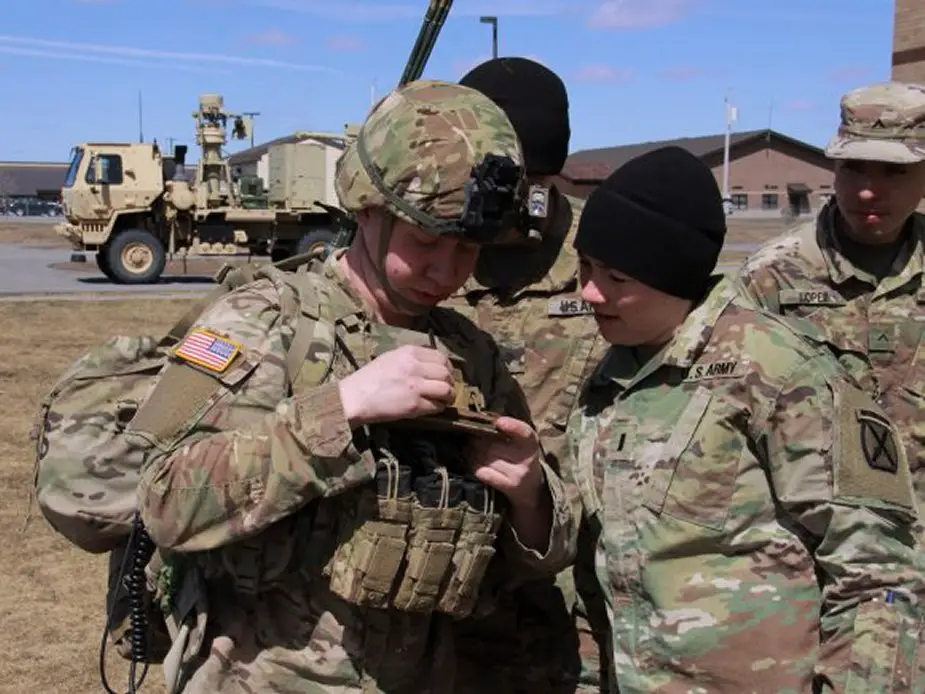U.S. soldiers work on improving their efficiency by using Field Artillery command and control capabilities via modernized software on Android-enabled smartphones. The upgrades, such as receiving digital maps to enhance the ability to send precision target coordinates, are part of the Army's modernization effort known as Precision Fires-Dismounted.

Spc. Joshua Wilson (left) talks with 1st Lt. Megan Walden about the Precision Fires-Dismounted application on the Nett Warrior End User Device at Fort Drum, New York. He is assigned to 3rd Battalion, 6th Field Artillery Regiment, 1st Brigade Combat Team, 10th Mountain Division (LI). (Photo Credit: U.S. Army photo by Dan Lafontaine (PEO C3T Public Affairs))
As reported by Dan Lafontaine, PEO C3T Public Affairs, the 3rd Battalion, 6th Field Artillery Regiment, 1st Brigade Combat Team, 10th Mountain Division was the first unit to be fielded the PF-D, the new software application loaded on the Army's Nett Warrior End User Device. About 40 soldiers trained on the system in April at Fort Drum.
Battalion Commander Lt. Col. Thomas Goettke said Field Artillery modernization is critical, especially as the U.S. faces near-peer threats. The PF-D allows the user to receive an intelligence, surveillance and reconnaissance feed on a single platform, rather than having multiple systems that require numerous components, wires, cables and batteries. "The whole spectrum of digital capabilities is resident in this platform," Goettke said. "The system optimizes the performance of the user."
PF-D reduces the required training time, compared with legacy systems, because of its revamped, intuitive user interface that is similar in functionality to commercial handheld devices. Also, the power-generation burden has decreased because PF-D is smaller, lighter and eliminates stand-alone hardware from the old system.
"Soldiers love PF-D because it's easy to use," Goettke said. "In an Infantry brigade combat team, we're primarily dismounted. This new PF-D reduces the amount of batteries we have to carry, which is significant for the Soldier. You can make sure the functionality of that single piece of equipment is up and operationally ready instead of having a full rucksack layout of equipment."
Battalion Command Sgt. Maj. Russell Blackwell reiterated that developing the PF-D in a way that young Soldiers can understand is a big step for the Army. "A smartphone is something that our Soldiers see, know and use on a daily basis. Now, to be on the battlefield with that same technology is going to greatly enhance the skills of the Artillerymen in a way that we've never before seen. Even as the technology gets smaller and more maneuverable, we've not stopped making it more lethal," Blackwell said.
The Army's Project Manager Mission Command at Aberdeen Proving Ground, Maryland, oversees PF-D's acquisition, integration, testing and fielding. At the program onset, PM Mission Command partnered with Program Executive Officer Soldier to integrate PF-D onto the Nett Warrior.
"The Soldiers who will be using PF-D grew up as true 'digital natives' and have very clear expectations of how they want to interact with their devices. Early on, the team adopted a comprehensive approach to providing a simple and effective user interface based on significant input from forward observers throughout the Army," said Lt. Col. Chris Anderson, product manager for Fire Support Command and Control, assigned to PM Mission Command.
"Moving forward, we are pushing to accelerate the fielding of PF-D across the Army and replace our legacy systems with a truly state-of-the-art platform for putting steel on target."
Several thousand PF-D systems will be deployed across the Army in the next few years.
The U.S. Army Program Executive Office Command, Control and Communications-Tactical develops, acquires, fields and supports the Army's mission command network to ensure force readiness. This critical Army modernization priority delivers tactical communications, so commanders and Soldiers can stay connected and informed at all times, even in the most austere and hostile environments. PEO C3T is delivering the network to regions around the globe, enabling high-speed, high-capacity voice, data and video communications to a user base that includes the Army's joint, coalition and other mission partners.














